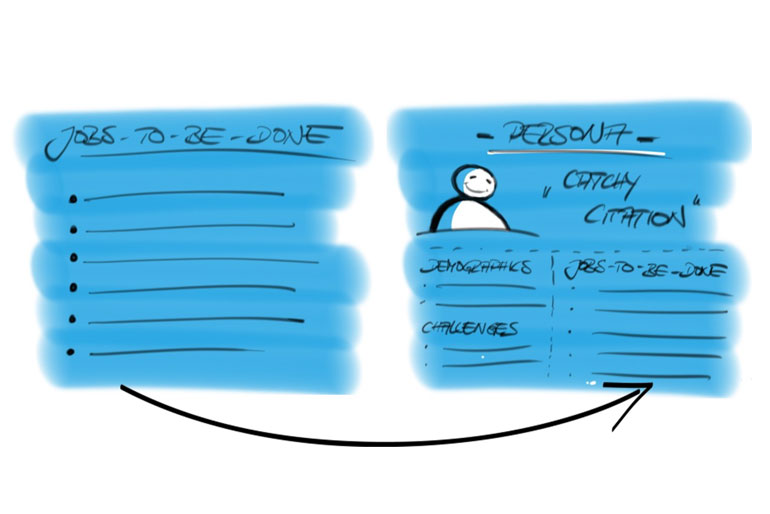Personas, Jobs-to-be-Done, Customer Journey Maps - how do I get this together?

By now, Design Thinking incorporates a wealth of possible methods and artifacts that can be applied in different process phases. This diversity can lead to increasing flexibility and even better insights; however, at the same time, especially inexperienced design thinkers are becoming increasingly insecure.
As part of a facilitator training in a large German corporation, we were asked how Personas, Jobs-to-be-Done and Customer Journey Maps relate to each other. Are there dependencies? Is there an ideal sequence?
First of all: with some experience and appropriate adjustments, the presented artefacts can be variably used in many project phases. It always makes sense to apply them in different contexts to gain experience and to adapt the methods and artifacts as well as the approaches used. Only by doing this, progress and further development are possible.
Nevertheless, you can say that the combination of different methods should ideally be done in a sequence that considers the inherent logic of the methods. Some methods require preparatory work to be meaningfully used and create comprehensive effects. The interaction between Personas, Jobs-to-be Done and Customer Journey Maps will be briefly outlined below.
Make user groups tangible with the creation of personas
Personas are archetypal users that reflect the needs and challenges of specific user groups. They help project teams to keep track of various user groups and, through their compact format (as a one- or two-page document, ideally as a poster), facilitate the overview of various requirement profiles. Since they are an essential element of user-centered product development, they should always be based on real, observable data. A part of Personas can also be tasks and goals which the respective user group typically has or wants to accomplish.
Capture and understand the tasks and motivation of the user groups
At this point, Jobs-to-be-Done come into play that can encompass various dimensions of task accomplishment and goal achievement. For example, Jobs-to-be-Done usually do not just describe the generic tasks that someone does (such as bringing out garbage, updating spreadsheets), but also the motivation behind them (having a clean flat, having a better basis for decision-making). In this sense, Personas and Jobs-to-be-Done should ideally be linked together as artifacts. Alternatively, the jobs of a user group can be made a distinct part of the Persona representing them.

With regard to the methodical development of the Persona and the Jobs-to-be-Done, the latter are usually the first ones to be available as they are generated through direct asking and observing. Personas are developed afterwards by combining the empirical data with the successive discovery of various user typologies.
Use Personas and Jobs-to-be-Done in Customer Journey Maps
When Jobs-to-be-Done and Personas are available, you can start creating a Customer Journey Map. A Customer Journey Map is a process graphic that is as easy to understand as possible, showing the feelings, challenges and problems of a user (or customer) in successive activities. Here, the logical sequence of methods described above becomes visible: a Customer Journey Map represents the typical journey of a user, for example through a service process. Therefore, it makes sense to use a previously developed Persona as a representative of an entire user group instead of a single, individual user. As a result, the Customer Journey Map gains credibility (it is based on empirical data) and can be generalized (user group X typically has these problems in this process).
However, it is also possible to map Jobs-to-be-Done in a Customer Journey Map instead of process activities. They can be extracted from the Persona and transposed into the Customer Journey Map.

By doing this, not only the tasks and underlying motivations of the Persona / user group can be presented. Also, other dimensions, such as tools and communication channels used, as well as problems and emotions related to task completion can be shown. At this point, it is helpful to put the tasks in an order so that a logical sequence is created – the resulting narrative in the Customer Journey Maps is clearer and easier to remember. Experience has shown that formats such as Customer Journey Maps do work well as documents in the context of workshops, as they start off with essential insights from upstream research phases.
As part of a working session, they can then serve as a foundation for further steps, such as identifying and prioritizing problem areas and using creative methods to find solutions.

Contact
14482 Potsdam
potsdam@d-labs.com
10245 Berlin
berlin@d-labs.com
70173 Stuttgart
stuttgart@d-labs.com
